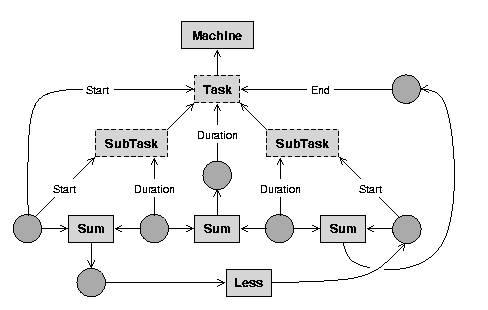EXCALIBUR
Adaptive Constraint-Based Agents in Artificial Environments |
|
[ Please note: The project has been discontinued as of May 31, 2005 and is superseded by the projects of the ii Labs. There won't be further updates to these pages. ]
|
Graph Elements for SCSPs
(Related publications:
[PUBLink] [PUBLink] [PUBLink])
A variable of the CSP is represented by a vertex with the label Variable.
It is graphically depicted by a circular vertex (see figure below).
Constraints could be represented by edges, but there are constraint types that
allow a variable number of variables to be included. These constraint types will
be called extensible constraints (Ce)
in contrast to nonextensible constraints
(Cn), such that
Ce
 Cn = C.
As the number of variables incorporated for extensible constraints may vary
throughout the search, there must be a simple mechanism to include/exclude
variables for constraints. Hence, a constraint is also represented by a vertex,
new edges to variables being added in order to incorporate them. A constraint
vertex's label corresponds to the type of the constraint. A constraint is
graphically depicted by a rectangular vertex.
Cn = C.
As the number of variables incorporated for extensible constraints may vary
throughout the search, there must be a simple mechanism to include/exclude
variables for constraints. Hence, a constraint is also represented by a vertex,
new edges to variables being added in order to incorporate them. A constraint
vertex's label corresponds to the type of the constraint. A constraint is
graphically depicted by a rectangular vertex.
An SCSP allows the existence of so-called object constraints. These
constraints do not restrict the variables' values, but provide structural context
information. For example, for the job-shop scheduling example of the chapter's
introduction, it must be known which two Start and Duration
variables together form a SubTask object. Otherwise, a Machine
constraint designed to check if the included SubTasks overlap might
combine Start and Duration variables of different SubTasks
for the check (see figure below). Object constraints act as a kind of structural
broker between variables and conventional constraints. They are represented by a
rectangular vertex with a dashed outline. Object constraints can be nonextensible
as well as extensible, Oe
 On = O, C
On = O, C
 O =
Ø. Constraints of C can be connected to variables and object
constraints, whereas object constraints can be connected to constraints of
C as well.
O =
Ø. Constraints of C can be connected to variables and object
constraints, whereas object constraints can be connected to constraints of
C as well.
Edges are used to connect vertex elements. The role/position of a variable (or
constraint when speaking about objects) within a constraint is often very
important. Thus, an edge's label and direction can be used to express its
role/position. An edge's direction is indicated
by an arrow and the label is displayed in the edge's middle (NoLabel if
omitted).
The figure below shows an example graph with an extensible conventional
constraint Machine, an extensible object constraint Task, two
nonextensible object constraints SubTask, three extensible conventional
constraints Sum and a nonextensible conventional constraint Less.
The Machine constraint ensures that the Start and Duration
variables of all connected SubTasks (via Tasks) do not produce
an overlap. The Sum constraint restricts the sum of
(

 )-connected variables to equal a
(
)-connected variables to equal a
(

 )-connected variable. The
Less constraint restricts the
(
)-connected variable. The
Less constraint restricts the
(

 )-connected variable to be less than the
(
)-connected variable to be less than the
(

 )-connected variable.
)-connected variable.

For questions, comments or suggestions, please contact us.
Last update:
May 20, 2001 by Alexander Nareyek
 Cn = C.
As the number of variables incorporated for extensible constraints may vary
throughout the search, there must be a simple mechanism to include/exclude
variables for constraints. Hence, a constraint is also represented by a vertex,
new edges to variables being added in order to incorporate them. A constraint
vertex's label corresponds to the type of the constraint. A constraint is
graphically depicted by a rectangular vertex.
Cn = C.
As the number of variables incorporated for extensible constraints may vary
throughout the search, there must be a simple mechanism to include/exclude
variables for constraints. Hence, a constraint is also represented by a vertex,
new edges to variables being added in order to incorporate them. A constraint
vertex's label corresponds to the type of the constraint. A constraint is
graphically depicted by a rectangular vertex.
 O =
Ø. Constraints of C can be connected to variables and object
constraints, whereas object constraints can be connected to constraints of
C as well.
O =
Ø. Constraints of C can be connected to variables and object
constraints, whereas object constraints can be connected to constraints of
C as well.


 )-connected variables to equal a
(
)-connected variables to equal a
(